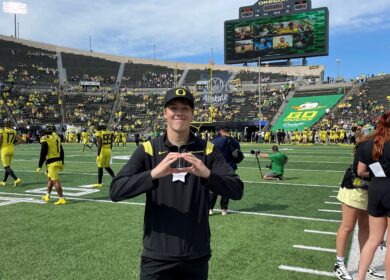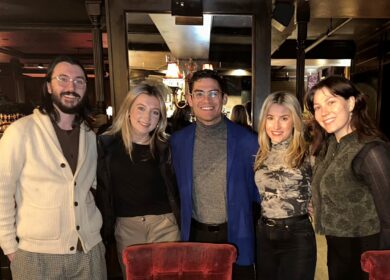
By Patrizia Heun, Account Executive, London
We all stared intensely in the direction of the box, curious what it might be that our colleague, Thorsten, would pull out of it next. He seemed quite excited, as if he really wanted to show us what it was, and this excitement was contagious. The first thing he had taken out was a giraffe — yeah you read correctly: a giraffe in all its glory. The next item seemed to be very heavy. “Look, guys! It’s the Pacific Ocean that I got in my plastic bag here. How amazing is that!” he said holding an imaginary plastic bag in his hand. A “Woooow! What else?” came from us and he went down to see what else he might find in his imaginary box.
This situation is not something from a kids’ book, nor the result of sleep deprivation. It was one of many games we played during our HAmoment — our official team-building event we hold on a regular basis. For the Hoffman Europe team, that meant one day full of improv. What started with a few sceptical faces and nervous laughter ended up being a great team experience with hearty laughter and some interesting insights — about us as a team, but also about skills we could relate to in the PR field. But let’s start from the beginning …
Improv – the art of freeing your mind and unleashing your creative side
Many people think improv — short for improvisational theatre — is “a bit weird” or “only for geeks.” What makes it sometimes a bit “weird-looking” — but mostly funny — is the fact that it’s a form of live theatre in which simply nothing, neither plot nor characters nor dialogues, are scripted or planned. Scenes and whole stories are made up in the moment, which means not everything necessarily makes 100 per cent sense (at least not in the traditional way). Improv is whatever immediately comes to mind. But as creativity and spontaneity are hard work, it’s a common approach to take input from the audience so that the actors can start or continue the story from there. Quite often the shows are comedy-focused as it comes more naturally than drama plots. But ultimately, everything is possible. From Scandinavian thriller to political satire.
Improvisational techniques have been proven to be quite useful even outside the theatre world. From psychotherapy to a training tool in education and business, where it can improve skills like teamwork, communication, creative thinking and problem-solving.

What improv teaches us about storytelling and teamwork
Now you might wonder: What the heck has improv theatre to do with PR? In fact, quite a lot. Especially when you look at the skills and lessons that improv can teach people.
Working in PR means finding stories where there don’t seem to be any on first sight, being creative no matter the situation, coming up with new ideas and all that as a team. While it might not sound hard, people often find themselves slipping into a certain routine (and getting stuck in it). Improv can deliver the techniques which act as disruptors of this routine, while improving interpersonal (work) relations. The latter is important because people can have very different approaches when it comes to working creatively. Which is why having a team that understands each other’s working methods and way of thinking is crucial. Here are the five key learnings we took away from our intense improv session:
Listening
When you’re playing a scene and performing as part of a group in improv, active listening is a key skill because you need to know what your vis-à-vis offers you to keep the scene going, and react to it. It’s the same in PR — no matter if it’s your client telling you about their objectives and giving input regarding a potential story, or your co-workers talking about a new idea: It’s essential to genuinely absorb what people say. The danger of missing important details is high, and humans tend to rather focus on what they are planning to say next, instead of concentrating on the person speaking. Improv teaches you to empty your mind and focus on the here and now. Make eye contact, listen carefully and then react accordingly. Believe me, it will help to create a more compelling story when you can use the little details and maybe even hear what hasn’t been said.
- Think on your feet
After absorbing the other person’s input, it’s the listeners’ time to react. Trusting your creativity and whatever your brain might come up with is the first step to being able to act truly spontaneous and flexible. This is something that will take a while and might need practising. Because what we learn over the years is to do the exact opposite: Think first before you speak. Which can turn into a barrier in the creative process — I’m not saying blurt out completely unrelated things that might come into your mind, but don’t be afraid to speak up and share your ideas. They might seem too extreme for you, but they could lead to a new angle.
- Think outside the box
Improv theatre is based on the people who offer and the partners who react to it. There are several improv techniques that can help to break the ice and to get in the right mindset. One of them is the famous “Yes, and …” approach. It’s the base for every improv actor as it’s a guide to keeping an open mind and also a great technique for brainstorming. Don’t block ideas; work with what you get.
Based on this technique, we went together in pairs during our improv class and planned the greatest parties. Free from all known boundaries, but full of random thoughts that popped in our heads:
“Let’s plan a party on an island in the Canaries.”
“Yes, and let’s invite Freddie Mercury’s ghost to give a concert for us.”
“Great, yes and let’s have everyone jump into a pool of Nutella!”…
This could go on for a while, but we ended up with parties that had angels and Freddie singing for us, dolphins to ride home on, fireworks, burning cocktails and a button to switch the location whenever you felt like it. Another example of a game that requires a bit more reacting to what your partner offered you, was called “Sorry, I’m late”. As the name implies, it started with someone being late — but it was the partner giving the person the reason why he or she was late. The task was to run with it and making a storyline out of it:
“Sorry, I’m late! I hope you didn’t wait too long.”
“That’s OK. But … please tell me what happened! Why do you smell so strongly like fish?”
“Oh, yeah that’s because I’m wearing my new clothes. They’re made out of fish skin — very sustainable and the latest trend in the fashion world. Plus, they are water- and windproof and ultra-light.”
Why are these games and approaches important for PR? Because ultimately you don’t tell clients what you can’t do, but what you can. In a PR context, that could mean: While the client’s proposal or claim might not be exactly right, you’ll find elements in it to work with.
It’s better to see it as the input that we’re here for to tweak and develop until it fits the purpose. So, say “yes” and … manage the expectations accordingly from thereon. Which brings us to the next point …
- Working in a team
But we shouldn’t stop there. In fact, we should use these skills to apply some approaches to our teams. Because a healthy work environment will ultimately have a positive impact on the work we do and the creative flow. The team will not perform well if one member is benefiting at the expense of others or is trying to run down other co-workers. Improv teaches you the importance of supporting each other by not judging ideas immediately (just because you haven’t thought of it that way doesn’t mean it’s bad). Not only will it block the creative flow, but it might also discourage the person who came up with the idea. So just run with it and see where it leads you. Use improv to increase trust and empathy to create a healthy work environment.
- The magic of storytelling & reincorporation
Improv encourages people to combine their thoughts to create something new and to merge seemingly unrelated ideas into one storyline. All the described tactics lead to a story, but what can become tricky — no matter if it’s a written story or a told one — is to keep the story alive. A useful tactic for improv actors is the reincorporation, meaning you start with a certain (relatable) story element and use it as a red thread throughout your performance and come back to it in the end. That way you keep the audience engaged as they will recognise the reference. The same strategy works for storytelling in blogs or articles of any kind. Create a theme or a frame, something that reoccurs within the narrative and makes it able to end it on that note.
Conclusion:
This summarizes what our Hoffman Europe team learned from our HAmoment improv session, which was, by the way, a lot of fun. Because in the end, enjoying what you do and having a good time while you’re doing it is the key to improv, PR and everything else you do.
I think improv offers something for everyone and will change the way you interact with others if you’re open for it. Of course, as with most things in life, it’s something that will improve with every time you try it, and while I realise not everyone has time or interest in taking improv classes in their free time, I’d suggest to try it at least once. Have a look in your imaginary box and see what your brain comes up with. You might be surprised by what you’ll learn.
And I promise: It’s got something in it for everybody (extrovert & introvert), and it’s impossible to walk out of a session without having learned something, no matter if you’re a leader, a team or an individual.

